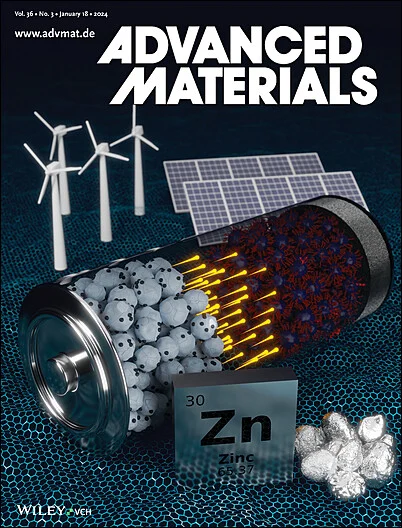Biomimetic Design of Breathable 2D Photothermal Fabric with Three-Layered Structure for Efficient Four-Plane Evaporation of Seawater
IF 27.4
1区 材料科学
Q1 CHEMISTRY, MULTIDISCIPLINARY
引用次数: 0
Abstract
2D photothermal membranes have demonstrated numerous advantages in solar desalination due to their flexibility, scalability, and low cost. However, their practical applications are limited by the restricted evaporation area and obstructed vapor channels. A biomimetic design of the breathable 2D photothermal fabric is reported, which is composed of two carbon-nanotube-hydrogel-coated polyester (PET) fabrics separated by fiber pillars, with the upper fabric layer having a hole array as stomatal channels. This fabric shows high solar-absorption efficiency (96.1%) and decreased water-evaporation enthalpy (1664.6 kJ kg−1). The hanging fabric as a heliotropic evaporator exhibits four-plane evaporation feature and achieves a high evaporation rate of 2.6 kg m−2 h−1 under sunlight (1.0 kW m−2) illumination, better than the traditional floated model (single-plane, 1.6 kg m−2 h−1). The evaporation rate can be further enhanced to 4.2 kg m−2 h−1 upon introducing adscititious airflow (2 m s−1). Simultaneously, the heliotropic-hanging design allows the dropping of concentrated brine, avoiding solid-salt-crystallization.

求助全文
约1分钟内获得全文
求助全文
来源期刊

Advanced Materials
工程技术-材料科学:综合
CiteScore
43.00
自引率
4.10%
发文量
2182
审稿时长
2 months
期刊介绍:
Advanced Materials, one of the world's most prestigious journals and the foundation of the Advanced portfolio, is the home of choice for best-in-class materials science for more than 30 years. Following this fast-growing and interdisciplinary field, we are considering and publishing the most important discoveries on any and all materials from materials scientists, chemists, physicists, engineers as well as health and life scientists and bringing you the latest results and trends in modern materials-related research every week.
 求助内容:
求助内容: 应助结果提醒方式:
应助结果提醒方式:


